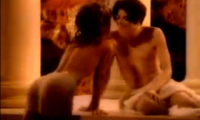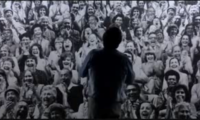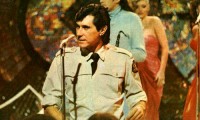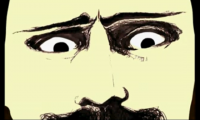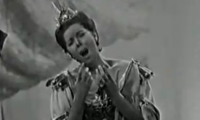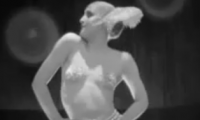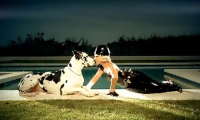Les Humphries Singers, “Motherless Child” (1971)
This has nothing to do with Michael Jackson, but to me it does. Jackson was a superstar who, with mega-talent and mega-technology at his disposal, created swollen, ideal fantasies of beauty, artifice and innocence.
This video features Liz Mitchell. Her face is not an ideal of beauty; it is beautiful, and it is sad and she is singing an old, old song about home and being lost, not just from a place, but from yourself, maybe even from your own body. The primitive quality of the video accidentally heightens this effect, makes it look like a broadcast from another dimension, where this soul has somehow, through some impossible cosmic mishap, incomprehensibly been imprisoned, or enslaved.
In Lynn Crosbie’s piercing eulogy for Michael Jackson on Ryeberg, she posts the video that went with his song “Childhood.” It is a haunting fantasy of dreamy, sleepy innocence, where children float above an enchanted forest, borne through a gentle night sky in simple, beautiful wooden sail boats, hanging languidly over the bows or playing slow-motion baseball. Michael sits alone on the forest floor looking up and singing in his purest, highest voice “Have you seen my childhood?”
It seems to have been written in response to the charges of child molestation leveled against him, and it pleads for the world to understand that he wanted to be with children because he wanted the illusion of being the child he was never allowed to be (I feel compelled to say that intuitively I do not think Jackson sexually molested the children sent to his house by their parents; however I think it must’ve been very strange for those children, at least one of whom was grievously ill, to feel such a complex and intense need coming towards them from a revered and powerful adult).
Michael Jackson, “Childhood” (1995)
The video is sad and beautiful. It is also sad and horrible. Horrible partly because the song is low-grade Broadway, and mostly because its images of childhood are so ideal and sentimental that they are static; they don’t allow any real feeling of childhood in. This is true also of the singer’s face; it is eerily, bizarrely beautiful. But it is beautiful in a way that has nothing to do with the singer’s natural face. The essence of his voice and heart is being translated through flesh so manipulated it appears nearly tortured. In the Neverland of music videos, the face is exquisite. In real life, it was probably rather hideous.
I cannot blame Michael Jackson for not wanting to live in “real life;” his circumstances made that impossible. But I wonder, what would be the impact of this song if Michael Jackson sang it with an un-altered, middle-aged man’s face? In public, without the fairy land of a video behind him?
Jimmy Scott, “Motherless Child” (Birdland, 2002)
This is “Little” Jimmy Scott, a jazz singer who has nothing to do with Michael Jackson, but who seems to me a spiritual relative. Scott, who was born in 1925 and who still lives and performs today, was born with Kallman Syndrome, a genetic condition which stunted his growth, prevented him from reaching puberty and gave him a high, feminine voice. He was neglected by his father, then orphaned at 13 when his mother was hit by a car; his career was wildly uneven in part due to prejudice and misunderstanding regarding his feminine voice; at one point in middle age, he was reduced to working in a hospital, probably as an orderly.
His power as an artist is impossible to separate from his “abnormality,” which he had no choice about and which he used with an amazing plangency and yieldingness that, because it was fully expressed, became a rare kind of force — the force of private emotional touch, the touch of love and longing. Scott too made art about the ideal.
Yet when I hear him, I hear the sadness, the impossibility of ideals such as love or beauty. He didn’t need technology, other than that provided by musicians; he communicated with his body, directly into the bodies of those lucky enough to be in his presence, the mystery and sadness of being human, ideally, hopelessly, brokenly.
Perhaps the comparison is unfair or just wrong. Scott was not a pop musician. He wasn’t seized at a tender age by the mechanical claws of the entertainment business, and the business is in any case less likely to destroy a person who patently has less broad appeal; also it did not at that time have at its disposal music videos, a 24-hour media and an entire culture which holds fame to be the highest possible human achievement, and/or which equates fame with love.
Cosmetic surgery existed, but it was nowhere near as sophisticated or as ubiquitous. In other words, while Scott had great hardship in life and struggled materially, he was far luckier than Michael Jackson because he was never tempted by Neverland — an enchanting place for inhuman creatures, but a terrible place for a person, especially if that person is there alone.
The Velvet Underground, “After Hours” (1969)
Edie Sedgwick has nothing to do with Michael Jackson either, but I consider her to be another spiritual relation, however distantly. People said that Michael Jackson was trying to make himself white, but it seemed more like he was trying to make himself inhuman. It seemed he wanted to do that partly in order to arrive at something beyond race or gender, in the pursuit of a pure ideal.
But because he was a human not only living in a culture with a particularly twisted relationship to beautiful ideals, but living in it as a pop star, he was bound to somehow represent that relationship; his pursuit of the ideal was knotted together with his human pain plus the projected pain and madness of an entire world population.
There was something terrible to me about the nature of Jackson’s artifice, his baroque style, and I am not sure why as all performers make use of artifice, even if Jackson was far more extreme than most. Maybe it was because the disjunction between his presented ideal and the nature of his crippled reality was both more shocking and somehow more visible: One of Jackson’s most original and endearing creations, his moonwalk, was like the repeated, stylized flinching of someone with a strong bodily memory of being hit, fear made not only fearless but charming — yet still recognizable under the charm.
That poignant disjunction is perhaps the secret core of the mad love for him, at least in this country: A country of record obesity with a fanatically thin, adolescent ideal of beauty, which photoshops already stunning models to appear in magazines bought by plain, over-worked, over-weight girls, in which working class people believed that a patrician fake cowboy was one of them and so elected him president, in which children increasingly live through passive fantasy identification with computer screens more real to them than physical life, and the greatest dream is to be famous, to become an American Idol star because you are loveable, not talented, which believes that the two qualities are the same thing.
In other words a powerful, over-weening, often brutal culture with a strong idealization of childhood and childhood desires, including the desire to be loved by the whole world as a child ought to be loved by its parents, simply by being him or herself, with all hurts and inadequacies which are themselves as beautiful as the most beautiful art. This is the love of narcissism, and it eats its object. It is not love at all.
Andy Warhol recognized and celebrated this desire, expressed in the formula: “In the future everyone will be famous for 15 minutes.” But Warhol was not under the illusion that his aesthetic of fakery was about love.
The Velvet Underground, “Venus in Furs” (1967)
This really doesn’t have anything to do with Michael Jackson. But it does have to do with the world into which he entered as a little boy; a world of glamourous artifice, egos and appetites (Warhol’s version of that world may’ve been very particular, but I think he understood its essence as well or better than anyone). It’s a terrible enchanted world, a synthetic Neverland — and yet, because Jackson entered it as a child with preternatural talent, he not only survived it for decades, but kept creating and giving within its confines — as Lynn Crosbie said in her essay, working “through the thunder” of his palpable suffering.
He was doing on an epic scale what all humans must do, keep going through the illusions, mistakes, hurts, conceits, self-hate and masks of human life, sometimes not having any idea if what is important to you actually has any value, or even knowing what is important to you. He reflected this struggle back to us and made it something other than stumbling through the neurotic mire, made it shiny, loud, dramatic and big.
This is nothing new; this is what stars do. It is why we sometimes value them more than artists whose work is actually better. It is an especially potent function when the star is a child; it is all the more so when the beautiful child star keeps working as an increasingly gifted, yet increasingly flawed, strange and ridiculous adult. It is potent to the point of superhuman when this child must negotiate the titantic forces of racism brought to bear on him from all directions before he is old enough to fully grasp who he is, yet who must not just negotiate these forces, but embody, channel, ameliorate and challenge them on a world stage, in out-sized Kabuki form.
All this while, dear God, simply trying to preserve the divine spark that he came here with, the spark that we all have, but that Jackson had to the hundredth power.
The Jackson Five, “I Want You Back” (1969)
“All I want! All I need!” I hope he found it. I hope he is finally home.
– Mary Gaitskill
